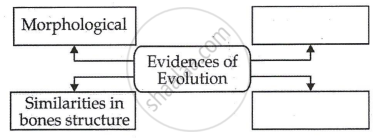Advertisements
Advertisements
प्रश्न
Define fossil.
उत्तर
Large number of organisms get buried due to disasters like flood, earthquake, volcano, etc. Remnants and impressions of such organisms remain preserved underground. These are called fossils.
APPEARS IN
संबंधित प्रश्न
State the connecting links between Peripatus with Annelida and Arthopoda.
What are vestigial organs?
Study the following statements:-
I. Wings of birds and wings of bats are homologous organs.
II. Wings of birds and wings of insects are modified forelimbs.
III. Wings of birds and wings of insects are analogous organs.
IV. Wings of birds and forelimbs of horse are homologous organs.
The correct statements are
(A) I and II
(B) II and III
(C) III and IV
(D) I and IV
State a reason for the increased population of dark coloured moths coinciding with the loss of lichens (on tree barks) during industrialization period in England.
Four students A, B, C and D reported the following set of organs to be homologous. Who is correct ?
(A) Wings of a bat and a butterfly
(B) Wings of a pigeon and a bat
(C) Wings of a pigeon and a butterfly
(D) Forelimbs of cow, a duck and a lizard
Attempt giving a clear definition of the term species.
Give the importance of fossil in support of organic evolution
Name the scientists who Discovered the fossil of Australopithecus
Explain the evolution of giraffe's neck according to Lamarck's theory of evolution.
Human tailbone is a vestigial organ. Explain.
The organs which perform similar functions but have different basic structure are called :
(a) asymmetric organs
(b) analogous organs
(c) homologous organs
(d) homophonic organs
One pair of organs in the following animals are not homologous. This is :
(a) forelimbs in humans and lizard
(b) forelimbs in lizard and frog
(c) wings in butterfly and bat
(d) wings in bat and bird
The wings of a housefly and the wings of a sparrow are an example of :
(a) analogous organs
(b) vestigial organs
(c) respiratory organs
(d) homologous organs
In a class, students were asked to observe the models/slides/pictures of the skeletons of forelimbs and wings of different organisms. After the observations the students made the following groups of homologous structures. Select the correct group :
(A) Wings of a bird and a butterfly
(B) Wings of a pigeon and a bat
(C) Wings of a butterfly and a bat
(D) Forelimbs of a cow, a duck and a lizard
Read the following statement and justify same in your own words with the help of suitable example.
There is evidences of fatal science among chordates.
Vestigial organ ______ present in human body is proof of evolution.
Write short notes based upon the information known to you.
Connecting link
The most common types of fossils are ------------------------.
Draw a labelled diagram of T.S. of a leaf showing Kranz anatomy.
Differentiate between connecting links and the missing links.
Define phylogeny.
Answer the following question:
What are homologous structures? Give an example. Is it necessary that homologous structures always have a common ancestor? Justify your answer.
Short answer question.
Give the significance of fossils.
Appendix : vestigial organ : : Peripatus : ____________
The decaying process of C-14 occurs continuously in dead organisms only.
Match the following.
| Column A | Column B |
| 1) Morphological evidences | a) Tail-bone or wisdom teeth |
| 2) Paleontological evidences | b) Leaf venation |
| c) Fossils |
Give scientific reason.
Peripatus is said to be the connecting link between Annelida and Arthropoda.
Explain any five types of evidence that support the theory of evolution.
The degenerated and non-functional organs found in an organism are called ______.
A human hand, a front leg of a cat, a front flipper of a whale and a bat’s wing look dissimilar and adapted for different functions. What is the name given to these organs?
Select vestigial organs from the following.
Select the correct statement.
Select the CORRECT match.
The fossil remains of Archaeopteryx is a connecting link between ______
Where is carbon dating used?
Cucurbits do not develop thick and woody stem as they are:
Palaeontological evidence for evolution refers to the ______.
Basic principles of embryonic development were pronounced by:
Study of fossils is ______.
Which is not a vestigial organ in a man?
The bones of forelimbs of whale, bat, cheetah and man are similar in structure, because ______.
As shown in figure below some organisms that share a common ancestor have features that have different functions, but similar structures.

These are known as ______. Give example.
Complete the following conceptual picture:

Pick the odd man out:
